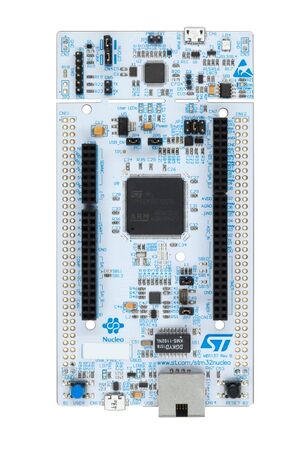NUCLEO-F767ZI
The NUCLEO-F767ZI development board uses the STM32F767ZI as the target processor.
This board is a rock solid development board with on-board ST-Link loader / debugger, using an STM32F103CBT6.

STM32F767ZIT6 in LQFP144 package
- ARM®32-bit Cortex®-M7 + DPFPU + Chrom-ART™ Accelerator
- 216 MHz max CPU frequency
- VDD from 1.7 V to 3.6 V
- 2 MB Flash
- 512 KB SRAM
- GPIOs (114) with external interrupt capability
- 12-bit ADCs with 24 channels (3)
- 12-bit DAC channels (2)
- USART/UART (8)
- I2C (4)
- SPI (6)
- General Purpose Timers (10)
- Advanced-control Timers (2)
- Basic Timers (2)
- Low-power Timers (1)
- Watchdog Timers (2)
- CAN 2.0B active (3)
- SAI (2)
- SPDIFRX 4 inputs
- SDMMC
- Camera Interface
- LCD-TFT Interface
- USB 2.0 OTG HS/FS
- Random Number Generator (TRNG for HW entropy)
- Ethernet
NUCLEO-767ZI Board Hardware Power indicator, green LED, LD6, illuminates when power is applied LED, LD1, PB0 (MBed documentation, not supported by schematic) Blue LED, LD2, connected to PB7, illuminates when driven high Red LED, LD3, connected to PB14, illuminates when driven high Bicolor Red/Green LED, LD4, illuminates during ST-Link activity Green LED, LD8, illuminates when power is enabled/applied to target USB VBUS Blue PushButton, B1, connects to PC13, creates a high signal (VDD) when pressed 32,768Hz crystal oscillator, LSE, used for Real Time Clock (RTC), connects to PC14 & PC15 8MHz HSE, is provided by the 8MHz crystal oscillator from the attached ST-Link, into PH0 UART3 connects the target processor to the ST-Link, providing a USB COM port connection on the host computer. Uses PD8 for TX, and PD9 for RX. ST-Link connects to TCK (PA14), TMS (PA13) 10/100 Ethernet Connections...